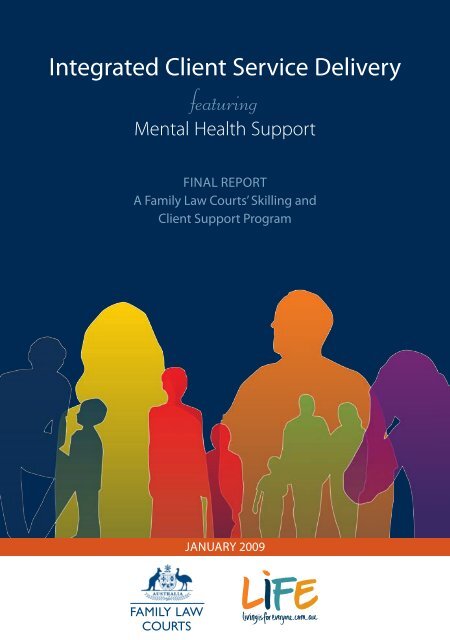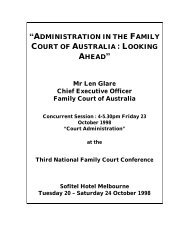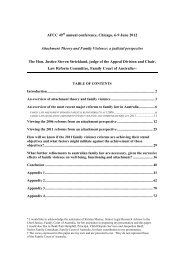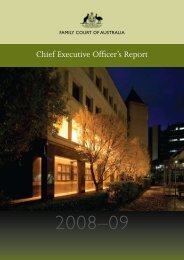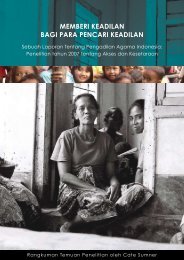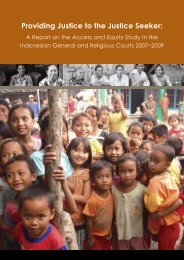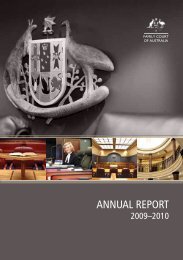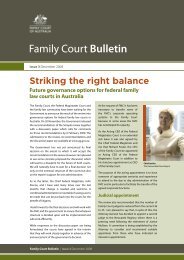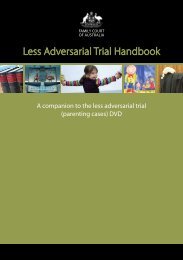Integrated client service delivery, featuring mental health support ...
Integrated client service delivery, featuring mental health support ...
Integrated client service delivery, featuring mental health support ...
You also want an ePaper? Increase the reach of your titles
YUMPU automatically turns print PDFs into web optimized ePapers that Google loves.
<strong>Integrated</strong> Client Service Delivery<strong>featuring</strong>Mental Health SupportFinal ReportA Family Law Courts’ Skilling andClient Support ProgramJanuary 2009
<strong>Integrated</strong> Client Service Delivery<strong>featuring</strong>Mental Health SupportFinal ReportA Family Law Courts’ Skilling andClient Support Programn Developing partnerships with<strong>mental</strong> <strong>health</strong> <strong>service</strong> providersn Raising staff awareness of<strong>mental</strong> illnessn Integrating <strong>mental</strong> <strong>health</strong> intobroader <strong>client</strong> <strong>service</strong> <strong>delivery</strong>.January 2009
iiThe Family Law Courts’ <strong>Integrated</strong> Client Service Delivery ProgramContentsAcknowledgementsForeword 1Background 2Mental Health Support Project 2<strong>Integrated</strong> Client Service Delivery Program 3The Program in brief 4What the Courts planned to do 4What the Courts did 4The results 5Awards 5<strong>Integrated</strong> Client Service Delivery Program 6Context 6Program aims 6Meeting the aims 7Benefits 9Project in detail 15Protocols 16The aims 16Meeting the aims 17Developing the protocols 20The achievements and benefits 21Program observations 23Referrals 24The aims 24The referral network 25The achievements and benefits 29Staff skilling and <strong>support</strong> 31The aims 31Pre-training awareness 32The five day training program 33Follow up, reinforcement and <strong>support</strong> 34The achievements and benefits 38Evaluation 41The evaluation approach 41The overall evaluation 42Training evaluation 43Focus group evaluation 43Building long term capability 44Glossary 46Further information 47iii
iiiThe Family Law Courts’ <strong>Integrated</strong> Client Service Delivery ProgramAcknowledgementsThe Family Law Courts wish to thankProduct Development andDeliverySteering CommitteeJustice Le Poer Trench (chair) – Family Courtof AustraliaChief Federal Magistrate Pascoe – FederalMagistrates CourtStephen Andrew – Family Court of AustraliaSue Hunt - Department of Health andAgeingAlan Woodward – LifelineDr Bryan Rodgers – Australian NationalUniversityClive Price – UnifamCourts StaffDinh TranGrant LedwichJan RamsdaleJulie ByrneJulie GreigKym HopwoodMarcus LeonardMardi JarvisNatalie McMahonNicole PriceNicolle SullivanPaul LodgeRosemary CrabbExternal ConsultantsLen Kanowski – Orygen Research CentreKatherin Coster – Pathways to PerformanceFay Jackson – Vision in MindTheresa Layton – Yarrendale EnterprisesPty LtdRaichel GreenProject ManagementRobert Gregory – Family CourtLeisha Lister – Family CourtRichard McPhetres – Richard McPhetres &Associates Pty LtdProject Development and FundingAustralian Department of Health and Ageingand the National Suicide PreventionStrategyExternal Referral Agencies forMental Health SupportNationalCrisis Support Services – Mensline AustraliaLifelineAustralian Capital TerritoryMental Health ACTRelationships Australia Canberra and RegionNew South WalesInterrelateRelationships Australia NSWAnglicare Diocese of SydneyMental Health Services of New South WalesHealthUnitingCare UnifamNorthern TerritoryAnglicare Resolve Northern TerritoryCentacare DarwinCrisis Line IncorporatedDanila DilbaHealth and Community Services NTQueenslandCentacare BrisbaneCentacare CairnsCentacare TownsvilleLifeline Community Care QueenslandRelationships Australia QueenslandSouth AustraliaCentacare South AustraliaMental Health Services SARelationships Australia SAUnitingCare Wesley Adelaide IncorporatedTasmaniaAnglicare Tasmania IncorporatedCentacare TasmaniaPositive SolutionsRelationships Australia TasmaniaVictoriaCentacare BallaratCentacare MelbourneCentacare GippslandCentacare SandhurstDrummond Street Relationship CentreFamily LifeLifeworksRelationships Australia VictoriaVictorian Department of Human Servicesand Area Mental Health Services
ivThe Family Law Courts’ <strong>Integrated</strong> Client Service Delivery ProgramCompanion CDWith this report is a companion CD that contains program resourcesincluding training slides and notes and a series of training scenarios.These were developed after the <strong>Integrated</strong> Client Service DeliveryProgram was completed, as part of the Courts’ ongoing commitment to improvedintegrated <strong>service</strong> <strong>delivery</strong>.
1The Family Law Courts’ <strong>Integrated</strong> Client Service Delivery ProgramForewordFamily breakdown is one of the most distressing eventspeople can experience. Couples who need to use court<strong>service</strong>s because they cannot resolve their differences byway of community-based dispute resolution can find itto be even more so. The reality is that by the time peoplereach the Family Law Courts (the Family Court of Australiaand the Federal Magistrates Court) stress, despair, anxiety,depression and other forms of <strong>mental</strong> illness are common,along with anger and frustration, and frequently a senseof powerlessness.While it is not the role of the Courts to provide professional <strong>mental</strong> <strong>health</strong> <strong>service</strong>s,Court staff members are very aware of the stress family breakdown places on <strong>client</strong>s.Through the <strong>Integrated</strong> Client Service Delivery (ICSD) program we are able <strong>support</strong>people’s <strong>mental</strong> <strong>health</strong> and general wellbeing by working directly with organisationsthat do provide professional <strong>service</strong>s.In addition, staff members are trained to communicate more effectively with <strong>client</strong>srequiring <strong>support</strong>, to prepare personal safety plans for <strong>client</strong>s who need them, torecognise signs of possible family violence and to respond sensitively to the needs ofIndigenous or culturally and linguistically diverse <strong>client</strong>s.The ICSD program aims to ensure that best practice <strong>client</strong>-focussed principles areincorporated into the Courts’ <strong>service</strong> <strong>delivery</strong> and is the first of its kind in an Australian court.It was structured to build on work the Courts have been doing to improve <strong>service</strong><strong>delivery</strong>. The forerunner of the program, the Mental Health Support Project, won asilver award in the 2008 Australia and New Zealand Mental Health Service AchievementAwards. The Court is proud of this recognition for what I believe is an excellent exampleof the improvement in <strong>service</strong> <strong>delivery</strong> to this group.The Courts give their sincere thanks to the Department of Health and Ageing. It <strong>support</strong>edand funded the Mental Health Support Project and then the <strong>Integrated</strong> Client ServiceDelivery Program under the Department’s National Suicide Prevention Strategy.Today there is a referral network of agencies able to provide <strong>support</strong> to the FamilyLaw Courts <strong>client</strong>s, in circumstances ranging from helping people feeling stressed tohelping people experiencing <strong>mental</strong> <strong>health</strong> emergencies. Courts’ staff members arebetter skilled and equipped in general communications and <strong>mental</strong> <strong>health</strong> topics andable to offer <strong>client</strong>s referrals to expert agencies.Although the program was developed for a court environment, I commend it to anyorganisation that is keen to improve its <strong>client</strong> <strong>service</strong>, with particular emphasis onimproved <strong>mental</strong> <strong>health</strong> <strong>support</strong>.The Hon. Diana Bryant, Chief JusticeFamily Court of Australia
2The Family Law Courts’ <strong>Integrated</strong> Client Service Delivery ProgramBackgroundThe Family Law Courts (the Courts) comprises the Family Court of Australia and theFederal Magistrates Court of Australia. Both Courts have jurisdiction in family lawthroughout Australia, except Western Australia which has its own Family Court. 1The Courts recognise that separation and divorce contribute to three-fold and fourfoldincreases in suicide rates for men and women respectively. Overall, men remainat the highest risk of suicide accounting for almost 80 per cent of all suicide deathsin Australia.General population studies report a consistently greater prevalence of a range of<strong>mental</strong> <strong>health</strong> problems in divorced and separated people, including generalisedpsychological distress and heavy alcohol consumption. 2Mental Health Support ProjectIt was within this context that in October 2004 the Department of Health andAgeing and the Family Law Courts initiated the Mental Health Support Project inthe Courts. A Memorandum of Agreement was signed between the Departmentand the Courts on 12 October 2004 for the Mental Health Support Project to runa pilot program at the Courts’ Darwin and Adelaide registries. The pilot tested avariety of approaches to improving <strong>mental</strong> <strong>health</strong> <strong>support</strong> for Family Law Courts<strong>client</strong>s. Independent evaluation of the pilot found:nnnnnnsignificantly improved staff skills for providing <strong>mental</strong> <strong>health</strong> <strong>support</strong> to <strong>client</strong>s<strong>client</strong>s feeling respected as an individual with specific needs rather than as anumber in a processreduced staff stress because staff were able to offer viable options to distressed<strong>client</strong>sa sustainable referral system with the capacity to link <strong>client</strong>s in need toappropriate counselling <strong>support</strong>protocols to guide staff through different levels of response to <strong>client</strong>s, fromsituations of immediate threat of harm to preventative measures, andthe availability of basic <strong>mental</strong> <strong>health</strong> literacy (a <strong>mental</strong> <strong>health</strong> brochureand key information in all relevant brochures and pamphlets of the Courts)increased <strong>client</strong> and staff awareness of <strong>mental</strong> <strong>health</strong> issues.The Mental Health Support Project pilot report is available on the resourcesCD inside the back cover of this report at www.familycourt.gov.au.1 Australian Bureau of Statistics, 2009, Suicides Australia, 2005, Cat. no. 3309.0 . viewed 21 January 2009,2 Australian Bureau of Statistics, 2009, Mental Health in Australia, A Snapshot, 2004-2005, Cat. No.4824.0.55.001, viewed 21 January 2009,
3The Family Law Courts’ <strong>Integrated</strong> Client Service Delivery Program<strong>Integrated</strong> Client Service Delivery ProgramAs the Mental Health Support Project pilot was completed, so too several other <strong>client</strong><strong>service</strong> initiatives of the Courts were reaching their conclusion. The learnings from allof these initiatives were gathered together into a new program to be implementednationally, the <strong>Integrated</strong> Client Service Delivery Program. This Program startedin 2006. It was jointly funded under an agreement between the Courts and theDepartment of Health and Ageing’s National Suicide Prevention Strategy.The funding agreement required these key outcomes:n Families and individuals identified as ‘at risk’ with <strong>mental</strong> <strong>health</strong> needs mustreceive <strong>service</strong>s that are accepting, confidential, <strong>support</strong>ive and appropriate totheir needs while they are in the court system.nnnCourts’ staff need to have gained greater confidence and competence toidentify, respectfully and appropriately respond to and refer individuals who areshowing signs of <strong>mental</strong> <strong>health</strong> needs.A comprehensive and timely evaluation of the program is undertaken.Information and methodologies are disseminated to other relevant agenciesand organisations.This report is a summary of the Courts’ <strong>Integrated</strong> Client Service Delivery Program,with a particular emphasis on the <strong>mental</strong> <strong>health</strong> benefits of the Program. The reportdraws extensively on the evaluations undertaken as part of the Program.While the Program is complete, the benefits continue to flow to the Courts’ <strong>client</strong>sand staff, as this report shows.The Courts have made funda<strong>mental</strong> shifts in the way they deliver <strong>service</strong>s to<strong>client</strong>s. The changes are ongoing. New <strong>client</strong> <strong>service</strong> staff will undergo the type oftraining outlined in this report as part of their induction. Existing staff will continueto receive <strong>support</strong> and training to ensure they maintain their knowledge, skills andcommitment to the approaches developed under the <strong>Integrated</strong> Client ServiceDelivery Program (see section Building Long Term Capability on page 44 forcurrent initiatives that are a direct result of feedback to this Program).The training will improve further over time as a direct result of feedback andevaluation. This recognises the dynamic nature of the environment of the Courts.
5The Family Law Courts’ <strong>Integrated</strong> Client Service Delivery ProgramThe resultsEvaluation feedback indicates that the Program has funda<strong>mental</strong>ly shifted how theCourts respond to and <strong>support</strong> <strong>client</strong>s who need counselling and other <strong>support</strong><strong>service</strong>s not available in the Courts but which impact on their capacities to interactwith the Courts and manage their cases in the Courts.It has significantly increased the capacities and confidence of staff to deal withpeople in most stressful or difficult situations. At the outset and as the Programdeveloped, some staff were concerned that the Courts would expect them todiagnose <strong>mental</strong> illnesses and/or be <strong>mental</strong> <strong>health</strong> experts at the end of thetraining. The Courts took every opportunity to allay such concerns before, duringand after the training: to affirm that the Program was about equipping staff withreferral networks, tools and knowledge to better <strong>support</strong> and interact with <strong>client</strong>s,especially difficult <strong>client</strong>s or <strong>client</strong>s with <strong>mental</strong> <strong>health</strong> and other issues.An unintended but welcome consequence of the training was the creation of amore <strong>support</strong>ive and less judg<strong>mental</strong> workplace.AwardsThe project has attracted nationaland international interest andrecognition. These awards havebeen received:nn2008 Achievement Award– Australia and New ZealandMental Health ServiceAchievement Awards.2007 Honourable Mention– Living is For EveryoneLiFE Awards, public sectorcategory. This is an awardunder the National SuicidePrevention Strategy.Julie Greig, Operations Manager in Adelaide, pictured with thesilver award for the Mental Health Support Program at theAustralia and New Zealand Mental Health Service AchievementAwards
6The Family Law Courts’ <strong>Integrated</strong> Client Service Delivery ProgramThe <strong>Integrated</strong> Client ServiceDelivery ProgramContextThe Family Law Courts recognise that separation and divorce can lead to increasesin depression, anxiety, substance use, 3 and increased suicide risk. The Courts alsounderstand that individuals with serious <strong>mental</strong> disorders have higher future ratesof divorce.In addition to these issues and the overall stress of separation and divorce, theCourts’ <strong>client</strong>s may also experience additional challenges, such as:nnnnnEnglish being their second languageidentifying with a different culture and different valuesbeing visually or hearing impairedexperiencing family violence, and/orlow levels of literacy.When developing the <strong>Integrated</strong> Client Service Delivery Program, the Courts asked‘how can we better <strong>support</strong> our <strong>client</strong>s given the challenges they face?’ To answer thisquestion the Courts drew on experts in <strong>mental</strong> <strong>health</strong>, communication, <strong>client</strong><strong>service</strong> and <strong>client</strong> diversity, as well as the extensive knowledge and experience oftheir staff.Program aimsWith funding <strong>support</strong> from the National Suicide Prevention Strategy, the primarygoal of the Program was to contribute to Australia’s suicide prevention effort bybetter <strong>support</strong>ing the <strong>mental</strong> <strong>health</strong> and emotional wellbeing of the Courts’ <strong>client</strong>s.A secondary goal, in recognition of the many challenges and stresses peopleexperience in family law situations at the Courts, was to provide better <strong>client</strong><strong>service</strong> overall.Specifically, the Program wanted to meet these objectives:n to provide <strong>client</strong>s with access to the resources, counselling and <strong>support</strong> theyneeded to look after their <strong>mental</strong> <strong>health</strong> and overall wellbeing (these are<strong>service</strong>s that are not available within the Courts)3 Rodgers, B. (1995). Separation, divorce and <strong>mental</strong> <strong>health</strong>. In Men and Mental Health (ed. A. F. Jorm), pp.105-115. National Health and Medical Research Council: Canberra.
7The Family Law Courts’ <strong>Integrated</strong> Client Service Delivery Programnnto ensure <strong>client</strong>s, particularly those who may be <strong>mental</strong>ly ill or distressed, weretreated with respect and without judgment by staff, andto ensure <strong>client</strong>s received <strong>service</strong>s tailored to their particular needs, withparticular attention paid to the needs of culturally and linguistically diverse<strong>client</strong>s and <strong>client</strong>s with fears for their safety.Meeting the aimsThe Courts delivered the Program through four major streams. The streamscovered the development of a referral network, making protocols available to staff,skilling staff and an comprehensive independent evaluation.1 ReferralsA referral network with organisations able to provide counselling and <strong>mental</strong> <strong>health</strong><strong>support</strong> <strong>service</strong>s to <strong>client</strong>s, gave <strong>client</strong>s immediate access to <strong>service</strong>s not available in theCourts, and ongoing <strong>support</strong>.Self-help brochures with information on <strong>service</strong>s that <strong>client</strong>s could independentlyaccess help (so take self-directed actions) were made widely available.2 ProtocolsNine protocols clearly set out the Courts’ expectations of staff in a range of <strong>client</strong> <strong>service</strong>situations, including emergencies when <strong>client</strong>s threaten to harm themselves or others.3 Staff skilling and <strong>support</strong>A national, integrated <strong>client</strong> <strong>service</strong> training program for staff encompassing<strong>mental</strong> <strong>health</strong>, family violence, diversity, special <strong>client</strong> needs and non-judg<strong>mental</strong>communication. The program incorporated the protocols and new referral processes.Improved registry <strong>support</strong> so that staff had better <strong>client</strong> <strong>support</strong> information andappropriate guidelines and standards; and knew that they were working in a <strong>support</strong>iveenvironment, with specific <strong>support</strong> mechanisms there to assist them after difficultinteractions with <strong>client</strong>s.4 EvaluationEvaluation to provide evidence on progress against intended outcomes to informcontinuous improvement processes in the Program and in the Courts, and also to providehelpful information for similar projects in other courts and agencies.
8The Family Law Courts’ <strong>Integrated</strong> Client Service Delivery ProgramDuring the Program the Courts:nnnnntalked to more than 150 community and government-based providers of<strong>mental</strong> <strong>health</strong> <strong>service</strong>ssigned more than 30 partnerships with <strong>mental</strong> <strong>health</strong> <strong>support</strong> providerstrained more than 500 staff across Australia (excluding Western Australia)between April 2007 and June 2008developed nine best practice protocols and made them available to all staff, anddistributed more than 100,000 self-help brochures to <strong>client</strong>s.darwinCairnstownsvillerockhamptonalice springsbrisbanelismoreAdelaidedubboparramattacanberraalburynewcastlesydneywollongongRegistriesLocation of trainingStaff trainedmelbournedandenonglauncestonhobart
9The Family Law Courts’ <strong>Integrated</strong> Client Service Delivery ProgramBenefitsFrom the outset the Courts believed that an approach delivering tailored,<strong>support</strong>ive and respectful <strong>client</strong> <strong>service</strong> would deliver benefits not only to <strong>client</strong>sbut also to community-based organisations, government and the Courts’ staff. Thatproved to be so.The following are highlights of what was achieved.Benefits for <strong>client</strong>sAn independent survey of more than 500 <strong>client</strong>s undertaken after the Program wasimplemented found that:nNinety-one per cent were satisfied with the<strong>service</strong> they received.nClients were served by staff who hadsignificantly higher levels of knowledge about<strong>mental</strong> illness, cultural diversity and safety; alsothe staff were <strong>support</strong>ed by protocols that were leading practice.Satisfied91%nClients were given information that was tailored to their particular situation,better preparing them for the court environment and the processes for theircase. This led to <strong>client</strong>s experiencing less stress and angst at the Courts.nClients who were distressed or <strong>mental</strong>ly unwell were able to accessconfidential counselling outside the Courts. Of those who accessed referral<strong>service</strong>s, 81 per cent were satisfied with the organisation to which they werereferred and the majority reported that their privacy had been respected.Benefits for staffWhile the primary aim of the Program was to provide <strong>service</strong>s for <strong>client</strong>s, there werealso positive benefits for staff. In particular, the evaluation found:nnnnnna sustained 27 per cent improvement in staff confidence, across alllocations of the Courts, to deal with a range of complex situations anddifficult <strong>client</strong>sstaff had increased and sustained confidence in helping <strong>client</strong>srequiring referralsa 90 per cent rating on confidence to empathise with <strong>client</strong>sa sustained capacity to understand and know how to applysafety and emergency protocols, as measured six months aftertrainingimproved perceptions of management <strong>support</strong> for their work, andreduced job stress.Further, the increased knowledge and understanding of staff regardingimprovement ins taff confidence27%
10The Family Law Courts’ <strong>Integrated</strong> Client Service Delivery Program<strong>mental</strong> <strong>health</strong> and emotional wellbeing (necessary to look out for and respond tosignals from <strong>client</strong>s) led to a much greater awareness and understanding of fellowemployees experiencing similar difficulties. This noticeably improved theCourts’ workplace.“It’s also good for me, you know, in my personal life.It helps me cope with my life better as well.”“It’s (<strong>mental</strong> <strong>health</strong> issues) more prevalent than Ithought...it’s everywhere in society. You really can’tmake a judgment by looking at people.”Courts’ staff – Colmar Brunton Evaluation“Everyone suffersfrom <strong>mental</strong> <strong>health</strong>issues at some pointin their lives, even allof us so called normalpeople here.”Benefits for the community sectorBefore the Program, community agencies reported minimal knowledgeof the Courts despite many of their <strong>client</strong>s being involved in Court processes. Thepartnerships that developed improved their knowledge (particularly through sitevisits) and provided insights into what their <strong>client</strong>s might experience at court.The partnership model proved popular with community organisations. Statementsmade during the evaluation included:“The set up is quite simple and it seems to work well”“The knowledge of the people we are dealing with is better than it used to be”a community-based organisationCommunity-based organisations also reported on the effectiveness of the warmlinking <strong>service</strong> 4 and the immediacy it provided.“We are not losing people and they are finding it a more comfortabletransition”“Most people get <strong>support</strong> on the spot rather than having to wait”Community-based organisation surveyed in the Colmar Brunton evaluationFurther, they believed the Courts to be at forefront of developing innovative<strong>service</strong>s for people with <strong>mental</strong> <strong>health</strong> problems. The partnership/referral modelwas one of the keys. All partner organisations believe the Courts have a role inreferring stressed, anxious or depressed people to community-based organisations.Benefits for government4 Warm linking is the direct and immediate connecting of <strong>client</strong>s to external <strong>service</strong>s by staff.
11The Family Law Courts’ <strong>Integrated</strong> Client Service Delivery ProgramImproving the Courts’ <strong>client</strong> <strong>service</strong> helped improve public perceptions aboutfamily law, an area often seen as difficult by the public. This improvement hasbenefits beyond the Courts given the range of government agencies dealing withseparating or divorcing people.The benefits can be extended further. The Courts now offer:n An independently evaluated and award-winning skilling program that istransferable to other agencies.nA model for developing partnerships with community-based organisations thatcan be used by other agencies.The Program has demonstrated the advantages of government and communitypartnerships delivering better <strong>service</strong>s for <strong>client</strong>s. Further, when <strong>client</strong>s are betterprepared and better able to participate in court processes the Courts also benefit,with reduced rework, happier staff and reduced complexity in <strong>client</strong> interactions.Knowledge reduces ignoranceClose to one in five Australian adults has experienced a common <strong>mental</strong><strong>health</strong> problem at some time during the last year. Given this, it is likely thatabout 180 of the Family Law Courts’ staff (there are 900 in total) will havesuffered from depression, anxiety or substance use disorder over the past12 months. Many will also have close family members or friends with a<strong>mental</strong> illness.One of the unexpected benefits of the Program was a change in attitudeamong staff toward common <strong>mental</strong> <strong>health</strong> issues. Staff stopped usinglanguage such as ‘crazy’, and began to treat each other with more respectand empathy. Several team leaders and managers reported the shift in attitudein the workplace.“Before I just didn’t know what do say. Now I feel like I know what tosay and how to behave when someone is upset or depressed.”Staff member in focus group“I can’t believe the change in the way people treat each other after thetraining.”team leader in a focus group5 Australian Bureau of Statistics, 2008, National Survey of Mental Health and Wellbeing: Summary ofResults, 2007, Cat. No. 4326.0, viewed 21 January 2009,
12The Family Law Courts’ <strong>Integrated</strong> Client Service Delivery ProgramReflections from the project managerMaking significant change to the culture of any organisation has its challenges.Staff often feel they ‘have been through it all before’. They can be cynical forvarious reasons: memories of previous experiences, they feel management haslittle concept of what it is to be providing direct <strong>client</strong> <strong>service</strong>, day-in, day-out;they suspect there is a hidden agenda, etc.In the case of the Family Law Courts’ <strong>Integrated</strong> Client Service Delivery Programthe challenges of the work environment were (and are) many. Staff consistentlyprovide <strong>service</strong>s to people who are recognised to be experiencing high levels ofstress as the Courts’ responsibilities are now confined to the ‘complex’ end ofthe family law <strong>service</strong>s spectrum. In addition to this, the <strong>Integrated</strong> Client ServiceDelivery Program had, as its main focus, the aim of improving the experiencesfor <strong>client</strong>s who presented at the Courts with <strong>mental</strong> illnesses.Some staff were suspicious that the Courts would expect them to diagnose<strong>mental</strong> illnesses and/or be <strong>mental</strong> <strong>health</strong> experts at the end of the trainingeven though that was not the case. Put this concern along side the fact thatthere were entrenched beliefs and attitudes toward <strong>mental</strong> illness, particularlysuicide (reflecting views held more broadly in society) and it made fora challenging change management program. It was most certainlynot a simple matter of re-engineering processes!The challenges ranged from:n achieving an acceptance of the need for externalsubject matter expertise at all levelsnnnnnto breaking down deep seated prejudicesto dealing with subjects that may be traumatic forsome staff who have been associated with suicide ordepression among family or friendsto overcoming fears of staff that they were being asked toact as cliniciansto developing partnerships with external organisations that operateddifferently, andto changing operational procedures.New doors wereopened and existingrelationshipsextended.
13The Family Law Courts’ <strong>Integrated</strong> Client Service Delivery ProgramThis required a significant amount of project time on people management(as well as project management) – managing perceptions, debunkingmyths, and building trust. But if there are two concluding observations tobe made it is these:n firstly, the passion and commitment of <strong>client</strong> <strong>service</strong> staff to serving the<strong>client</strong>s of the Courts to their best abilitynsecondly, the leadership that was shown not just by those in leadershiproles but also by individuals who became advocates and leaders ofchange with their peers.Over the life of the Program there were some extraordinary shifts in staffattitudes and funda<strong>mental</strong> improvements for <strong>client</strong>s and staff. There wereunforeseen benefits in the workplace as staff developed much improvedunderstanding of <strong>mental</strong> illness, and with it greater compassion.A strength of the Program was that it had a clear evidence base. This wasimportant for building the case for change with staff and for ensuring bestpractices were implemented. The Courts collected and used evidence fromexternal experts, <strong>client</strong> survey data, focus group data, data from an externalproject evaluator and pilot results and experiences to build a firm evidencebase. Plus there was opportunity for significant contribution from staff as theproducts and approaches were built. This was essential for achieving overallstaff buy-in.The Courts were met with enthusiasm by the government and communitysectors when approached to work in partnership to better <strong>support</strong> <strong>client</strong>s.New doors were opened and existing relationships extended.The Program has shown that where there is a will, and the resourcesto <strong>support</strong> a change process, there truly is a way. In this case, therewas organisational <strong>support</strong> at the highest level based on a clearacknowledgement that separation and divorce has affects on people’s <strong>health</strong>and wellbeing far beyond the Courts’ responsibilities to them. Further,that when organisations, in this case two courts, can find ways to work inpartnerships with other <strong>service</strong> providers, then the benefits – to individuals,the courts, the community and governments – are multiplied beyond theinvestment. And for staff, where they are <strong>support</strong>ed appropriately, it ispossible to make substantial organisational change over a relatively shorttime frame.Project manager
14The Family Law Courts’ <strong>Integrated</strong> Client Service Delivery Program
15The Family Law Courts’ <strong>Integrated</strong> Client Service Delivery ProgramProject in detailThe following sections of this report discuss the aims, achievement and challengesof the project in more detail. It is structured by the four project <strong>delivery</strong> streams:nnnnprotocolsreferralsstaff skilling and <strong>support</strong>, andevaluation.
17The Family Law Courts’ <strong>Integrated</strong> Client Service Delivery ProgramMeeting the aimsEight protocols were developed. Each contains steps that <strong>client</strong> <strong>service</strong> staff shouldfollow when providing <strong>client</strong> <strong>service</strong>s and <strong>support</strong>ing information, such as tips andscripts. These are the protocols:1 Aboriginal and/or Torres Strait Islander protocol – to guide <strong>service</strong> to peoplewho identify as Aboriginal and/or Torres Strait Islander.2 Diversity protocol – to guide <strong>service</strong> for <strong>client</strong>s who are from a differentcultural or linguistic background or have low literacy levels.3 Preventative protocol – a guide to offering counselling <strong>support</strong> to all new<strong>client</strong>s in recognition that separation and divorce is difficult.4 Responsive protocol – to guide <strong>service</strong> when a <strong>client</strong> is showing signs ofdistress, depression or <strong>mental</strong> illness.5 Emergency protocol: suicide threat – a guide to situations where <strong>client</strong>sthreaten to harm themselves.6 Emergency protocol: threat of harm to others – a guide to dealing withthreats of harm to others, including staff.7 New <strong>client</strong> protocol – a guide to dealing with new <strong>client</strong>s.8 Safety at court protocol – a guide for providing <strong>service</strong> to people who fear fortheir safety while at court.
18The Family Law Courts’ <strong>Integrated</strong> Client Service Delivery ProgramThe protocols:nnnnnare <strong>client</strong> centricclearly communicate expectationsare evidence based, nationally consistent and consistent with policycover a wide and complex array of <strong>client</strong> <strong>service</strong> situations, andare easy to use, particularly in emergency situations (eg. they are NOT aprocedures manual).The protocols apply to all staff, however they are particularly useful to new, lessexperienced staff or staff under pressure who are unsure of what to do or say. Moreexperienced staff also refer to them as a checklist or in more complex or stressfulsituations.The protocols:are limited to one page of stepscontain step-by-step approachesare colour coded (making for instant recognition) and available on both theintranet and in flip folders to <strong>support</strong> different ways staff workinclude tips and scriptstell the ‘why’ of doing each step so the <strong>client</strong> <strong>service</strong> officers understand whatthey are trying to accomplishCopies of all protocols are available on the attached resource CD.
19The Family Law Courts’ <strong>Integrated</strong> Client Service Delivery ProgramSample protocolPreventative referral protocolThese steps must be followed for all <strong>client</strong>s of the Courts.Engage Client and describethe referral programWhen you describe the referral program:• Acknowledge that separation is a difficult time• Ask the <strong>client</strong> if they already have someone totalk to.• Explain that this is a program that offers links to<strong>support</strong> and information to all <strong>client</strong>s.• Explain <strong>service</strong>s are separate from FLC (external).Give <strong>service</strong> provider optionsProvide some options:• Refer to community referrals page on the intranetunder preventative Mental Health protocols.ConsentreceivedTelephoneLinkAsk for referral consentSend/Hand outbrochures andcontact details forlocal <strong>service</strong>EmailPrepare andsend email.Consent notreceivedLet the <strong>client</strong> know what happens nextENDENDWarm transferExplain there will be a slight delay while you get the CBOon the phone and that once introduced you will drop out ofthe call.Cold transferAdvise the <strong>client</strong> that you will transfer them to the CBO.Ensure they understand what the <strong>service</strong> can assist themwith. Advise there will be a short delay while you put themthrough.Call backAdvise the <strong>client</strong> that you will provide the <strong>service</strong> withtheir first name and contact phone number, and that the<strong>service</strong> will contact them. Advise of timeframes and checkif there is a specific time when contact is preferred.Link via e-mailAdvise the <strong>client</strong> that you will e-mail their details to theappropriate <strong>service</strong> and that the <strong>service</strong> will contact the<strong>client</strong> with the specific time frames, and check if there is aspecific time when contact is preferred. All fields in the e-mail template must be filled in. Send the e-mail while the<strong>client</strong> is still on the line or at the counter and then concludethe conversation.Make appropriate contact withService Provider
20The Family Law Courts’ <strong>Integrated</strong> Client Service Delivery ProgramDeveloping the protocolsFive primary steps were used to develop the protocols.12Developing a first draft of the protocols in partnership with subject expertsThis helped ensure the steps were correct and accompanying dialogue (script) wasconsistent with current evidence. The experts covered:n <strong>mental</strong> <strong>health</strong>n Aboriginal and/or Torres Strait Islandersn culturally diverse <strong>client</strong>sn communication techniques.Their input gave the protocols credibility in the eyes of staff, thus the confidence to usethe protocols in difficult situations.Adapting the protocols to the workplace by using highly-regarded <strong>client</strong> <strong>service</strong> stafffrom each region and functionA staff reference group tested the protocols, refining them as necessary for the Courts’environment. This involvement by respected local staff encouraged broader buy-in.345Testing, retesting and refining the protocolsReference group members tested and refined the draft protocols repeatedly using roleplays, consultation, and trials in local registries. This not only improved the quality of theprotocols but also encouraged further staff buy-in.Integrating the protocols into trainingThe skilling program (see Staff Skilling and Support on page 31) was used toimplement the protocols. This included providing staff a ‘safe’ environment in which totest the protocols.Making the protocols available in the workplaceConcurrently with the <strong>delivery</strong> of the training, the protocols were made available to staffin hardcopy flip folders and on the intranet to encourage immediate use.During the staged national roll-out of the skilling program, the Courts continuedto refine the protocols based on feedback from training forums and staff in theworkplace. The challenge was to keep the protocols current in such a dynamicenvironment.
21The Family Law Courts’ <strong>Integrated</strong> Client Service Delivery ProgramThe achievements and benefitsThe evaluation found the introduction of the protocols, combined with the skillingprogram, led to a 31 per cent increase in staff confidence when dealing with theCourts’ most challenging <strong>client</strong>s, particularly <strong>client</strong>s with <strong>mental</strong> <strong>health</strong> problems(eg. schizophrenia) and <strong>client</strong>s with drug and alcohol problems.Staff confidence to produce safety plans (for individual <strong>client</strong>s) rose from 67 percent to 86 per cent as a result of the protocols and training.Confidence ratings also rose significantly with the introduction of the protocolsand training for interacting with Aboriginal and/or Torres Straight Islander <strong>client</strong>s,culturally and linguistically diverse <strong>client</strong>s, those with low literacy and <strong>client</strong>s withsafety fears. The confidence ratings remained at more than 86 per cent in each area.Across the Courts staff were satisfied with the protocols, particularly the safety atcourt and <strong>mental</strong> <strong>health</strong> protocols.The emergency protocolshave quite possibly savedlives (see letter at right).In a sample month at theend of 2008, the NationalEnquiry Centre alonehad taken 11 calls where<strong>client</strong>s threatenedself-harm and theemergency protocolwas applied.98 per cent ofstaff surveyedwere confidentin applyingemergency andsafety at courtprocesses.A grateful <strong>client</strong>
22The Family Law Courts’ <strong>Integrated</strong> Client Service Delivery ProgramChallenging myths and changing approachesThe Program has helped debunk myths and given <strong>client</strong> <strong>service</strong> staff the skillsto know how to more effectively engage with <strong>client</strong>s.Myth If you ask a <strong>client</strong> if they are thinking of harming themselves theyare more likely to do it.factAsking a suicidal person if they have a plan to do self-harm doesnot increase the suicide risk. In fact, speaking to them may calmthe person and allow the staff member to refer them to help, and/or allow the <strong>client</strong> <strong>service</strong> officer time to give critical informationto police.The <strong>mental</strong> <strong>health</strong> emergency protocol for suicide guides staff to keep theperson talking, alert a colleague or supervisor and ask the person directly ifthey have a plan.“She [the <strong>client</strong>] said that she had done everything [asked of her] and justwanted this matter behind her, and after speaking a bit longer she said that she‘may as well just hang myself’.“I asked her ‘Are you really thinking of doing that?’ and she replied ‘Yes’. Iasked her ‘Do you have a plan for doing this?’ to which she also replied ‘Yes’.“At this point I alerted my supervisor via a written note that I had a <strong>client</strong>on the phone threatening suicide.” The staff member went on to follow theprotocol, alerting a supervisor and trying to get details of the caller, pressing thetrace button and alerting police.”Incident report from the Courts’ National Enquiry Centre
23The Family Law Courts’ <strong>Integrated</strong> Client Service Delivery ProgramThe <strong>mental</strong> <strong>health</strong> responsive protocol for possible <strong>mental</strong> illness requiresstaff to try and calm the person down, determine what type of referralthey may need, warm link the <strong>client</strong> (if they agree) and then take the actionrecommended by the <strong>mental</strong> <strong>health</strong> professional.“Having calmed the <strong>client</strong>, I then informed the [judicial officer’s] associate ofthe <strong>client</strong>’s state of mind and advised that I would seek help for her. It was welland truly after 5pm, I took the <strong>client</strong> and her <strong>support</strong> people into the registrywhere I then explained to the <strong>client</strong> what I could do to assist her if she agreed.“With her agreement I then contacted the Adelaide Mental Health Crisis teamand spoke with the triage nurse who conducted an over the phone assessmentwith the <strong>client</strong> and then advised me that the <strong>client</strong> required hospitalisation.“With the assistance of the <strong>client</strong>’s <strong>support</strong> people we were able to organisetransport from the Registry and admit the <strong>client</strong> to the District Hospital’s<strong>mental</strong> <strong>health</strong> unit.“I also arranged for her dog to be cared for – this was an issue of concern forthe <strong>client</strong> as she lives alone.”Incident report from the Adelaide RegistryProgram observationsPreconceived beliefs of staff about suicide and <strong>mental</strong> illness were difficult to shiftand required a prolonged and ongoing effort. Approaches that helped bring abouta shift in attitude included:nnnnnbeing clear that the protocols were developed by leading expertsemphasising that the steps in the protocols were good practice, endorsed bythe Courts and <strong>mental</strong> <strong>health</strong> <strong>support</strong> agencies, and that other approacheswere not good practicerunning a two-day <strong>mental</strong> <strong>health</strong> training module to start to change attitudeshearing directly from crisis <strong>support</strong> teams that deal with suicide threats on adaily basis, with Courts staff being able to ask questions of them, andintegrating the approach set out in the protocols into staff performancemanagement tools.
24The Family Law Courts’ <strong>Integrated</strong> Client Service Delivery ProgramReferralsSeparation is one of life’s most stressful events. Only three life events – the deathof a spouse, death of a child and imprisonment – are considered more distressingthan divorce. Thus people going through the Courts are often emotionally charged.Much is at stake for both parties and signs of emotional distress and <strong>mental</strong> illnessare common among the Courts’ <strong>client</strong>s.The Courts’ <strong>client</strong> <strong>service</strong> staff are neither counsellors nor <strong>mental</strong> <strong>health</strong> experts yetdaily they interact with people who are at a higher risk of emotional distress thanthe general population (and most likely could benefit from counselling <strong>support</strong>).The aimsThe Courts wanted to ensure:nnn<strong>client</strong>s were aware of the <strong>service</strong>s provided by community-based andgovernment organisations<strong>client</strong>s were able to get help from appropriately skilled counsellors, and<strong>client</strong>s were able to access self-help information.To achieve these goals the Courts:nnnset up a referral network of community and government organisations willingto provide counselling and <strong>support</strong> <strong>service</strong>s to <strong>client</strong>s and receive directreferrals from the Courtsskilled and <strong>support</strong>ed staff in offering and making referrals, andprovided <strong>client</strong>s with– information on the <strong>service</strong>s available, and– self-help tools related to <strong>mental</strong> <strong>health</strong>.
25The Family Law Courts’ <strong>Integrated</strong> Client Service Delivery ProgramThe referral networkThe Courts recognised the importance of working across sectoral andorganisational boundaries to ensure <strong>client</strong>s received <strong>mental</strong> <strong>health</strong> <strong>support</strong> asthey moved through the family law system. This required the Courts to buildpartnerships with community and government providers of <strong>mental</strong> <strong>health</strong><strong>service</strong>s. With partnerships in place, the Courts could link <strong>client</strong>s to organisationsable to <strong>support</strong> people under the emotional strain of separation or divorce.When establishing the referral network, the Courts were guided by the followingprinciples:nnnnall members of the network must have suitably qualified counselling staffit must be simple and attractive for community-based organisations to join theCourts’ referral networkthe network as a whole must cover the needs of the Courts’ diverse <strong>client</strong>groups and a wide range of <strong>mental</strong> <strong>health</strong> circumstances, andnetwork members must be able to offer referrals that:– maintain <strong>client</strong> privacy– are completely independent of the Courts, 7 and– can be anonymous if the <strong>client</strong> chooses.More than 30 <strong>mental</strong> <strong>health</strong> <strong>support</strong> agencies across all states (except WesternAustralia) joined the referral network. Many of the agencies offer regional <strong>service</strong>s.Two national telephone counselling <strong>service</strong> providers, Lifeline and Mensline, assured<strong>client</strong>’s had access to some form of counselling <strong>service</strong> regardless of location.7 During a pilot project <strong>client</strong>s expressed concern that admitting to requiring or using counselling wouldimpact the outcome of their case
26The Family Law Courts’ <strong>Integrated</strong> Client Service Delivery ProgramThe types of <strong>service</strong>s provided across the Network through email, telephone andface-to-face <strong>service</strong>s included:nnnnnnnnnnnnnnnnnnnnnnshort and long term counsellingrelationship programslinkages to local <strong>service</strong>scall-back <strong>support</strong> <strong>service</strong>schildren’s <strong>support</strong>women’s and men’s <strong>service</strong>syouth counsellinggrandparent <strong>support</strong> programsAIDS/STD, drug and youth programsfamily counsellinghomeless and parenting programssuicide intervention programs<strong>mental</strong> <strong>health</strong> assessment and treatment if necessaryattendance on site (ambulance, police and some State <strong>mental</strong> <strong>health</strong> <strong>service</strong>s)domestic violencecounselling for Australian veterans, peacekeepers and their familiescrisis intervention, medical assistance, housing and addiction managementlegal <strong>service</strong>sAboriginal and Torres Strait Islander <strong>support</strong>grief and loss counsellingalcohol, drug and gambling help, and<strong>support</strong> for homelessness.While the Courts’ <strong>client</strong>s could be referred to the <strong>support</strong> network to receivecounselling, many of the organisations offered broader <strong>service</strong>s including financial,legal, parenting, housing and addiction <strong>support</strong>. Most organisations were also ableto provide referrals to other specialist <strong>service</strong>s where required.Access to the Network, including ‘warm-linked’ referrals have continued beyond theProgram.
27The Family Law Courts’ <strong>Integrated</strong> Client Service Delivery ProgramBuilding the referral networkRelationship building was a key to establishing the referrals network. The Courtsused these broad steps for building the network:12345Identify potential referral network partnersThis was done through a multitude of methods, including by drawing on existingnetworks and partnerships, nationally, regionally and locally, and other researchtechniques to identify candidate partners in each region.Meet to gauge interest from both sides and introduce local staffExplain the Program, clarify what the Courts would bring to the partnership and whatpotential partners might be able to offer.Develop partnership agreementsStatements of Understanding set out how the Courts and their partners would worktogether (the <strong>service</strong>s to be offered, etc). As community organisations often haveminimal resources, the Courts normally took on administrative responsibility fordeveloping the Statements of Understanding.Celebrate the partnerships using a launch or formal signingPartnership launches, including a formal signing and lunch or morning tea gave a senseof occasion and importance to the partnerships.Foster the relationship with staffManagers in the Courts’ registries were expected to arrange reciprocal visits for staff andreferral network partners, and manage the on-going relationship at the local level.
28The Family Law Courts’ <strong>Integrated</strong> Client Service Delivery ProgramOffering and making referralsStaff needed to know how to sensitively, confidentially and confidently offer andmake referrals. There were three broad circumstances in which staff might makereferrals:nnnpreventative referrals – when <strong>client</strong>s were new to the Courts. In recognitionof the stress of separation and divorce, new <strong>client</strong>s were offered counselling<strong>support</strong> regardless of whether they were showing outward signs of distress.responsive referrals – when <strong>client</strong>s were showing signs of distress, anger orwere visibly upset (this might have included threats about future suicide), andemergency referrals – when a <strong>client</strong> threatened imminent harm to themselvesor others.With the help of a <strong>mental</strong> <strong>health</strong> expert, the Courts developed a series of protocolsdocumenting best-practice steps to making different referrals (see page 27). Theseprotocols then became the basis for training modules on how to offer and makereferrals.The training also showed staff where to find information on the types of referralseach community/government organisation could accept. One of the advantages ofdeveloping the formal partnerships was having that information directly availableto ensure <strong>client</strong>s were referred to the best organisation for their particular needs.The Courts found staff more likely to offer and make referrals if they were familiar witha referral organisation and the <strong>service</strong>s it offered. To increase familiarity the Courts:nnnorganised staff visits to local community organisationsprovided information about the referral network during the skilling program,andintegrated information about community organisations into the protocols.Providing information to <strong>client</strong>sThere are many reasons why <strong>client</strong>s do not accept, particularly in the first instance,a direct referral to counselling <strong>support</strong>. During the Program, the most commonlycited reasons were – ‘don’t need or want it at the time of offer’ (54 per cent) or‘already had <strong>support</strong>’ (14 per cent). Some <strong>client</strong>s were concerned that a referralmight affect their case at court, particularly where children were involved.Mental <strong>health</strong> experts advising the program advised that people rarely take thefirst offer of a referral. In fact, the effect of being provided referral information iscumulative and a person will often not take-in or use the information until it hasbeen offered multiple times.To <strong>support</strong> the offers of direct referrals offers made by staff, the Courts developeda brochure titled Feeling stressed?. It provided practical tips and guidance to <strong>client</strong>s
29The Family Law Courts’ <strong>Integrated</strong> Client Service Delivery Programon looking after their <strong>mental</strong> <strong>health</strong> during separation. Thebrochure included contact details of some key referral networkmembers and was:nnnhanded out as part of an information pack for all new<strong>client</strong>sprovided to <strong>client</strong>s over the counter if they display need,andavailable in registry waiting areas.Some registries also provided <strong>client</strong>s with a list of local referralnetwork members and had information brochures of referralnetwork members available.The achievements and benefitsMost commonly the Courts’ new <strong>client</strong>s were made awareof the referral <strong>service</strong>s when they first contacted the Courts,generally through the Courts’ National Enquiry Centre.Information was given verbally and through the post.While most <strong>client</strong>s felt they did not have an immediate need orwant for the <strong>service</strong>s at the time they were offered, they wereappreciative of being offered the referral.“There is a lot more information now about the courts, whatto do, what the process is like, where to get help”<strong>client</strong> from the Colmar Brunton Social Research evaluation“The fact that they care enough to ask and offer that is good.Just to know there are places I can get extra <strong>support</strong> from is agood thing in itself”<strong>client</strong> from the Colmar Brunton Social Research evaluation“Staff of the Family Court…much more helpful. They used tojust check forms and if you wanted any help you had to reallywork for it or hire a lawyer. Now they offer you help andassistance every time I call. People who are whingeing aboutthe courts have no idea how lucky they are now”<strong>client</strong> from the Colmar Brunton Social Research evaluation
30The Family Law Courts’ <strong>Integrated</strong> Client Service Delivery ProgramThe Courts’ National Enquiry Centre is the first point of contact for almost all <strong>client</strong>s.Staff reported many <strong>client</strong>s (about 28 per cent) were emotionally distressed whenthey called. When offered a referral, staff reported no negative reactions. In factmany distressed <strong>client</strong>s were positive about being offered referral information andmore than half (about 53 per cent) either received a direct phone link (a ‘warm link’)to a community organisation or agreed to receive contact information.Of the <strong>client</strong>s that received counselling through such a referral, satisfaction withthe <strong>service</strong>s received was strong at 81 per cent. Further, the great majority of <strong>client</strong>sbelieved that their confidentiality was respected.Staff appreciated having a network of professional <strong>mental</strong> <strong>health</strong> <strong>support</strong> to drawon, particularly in emergency situations and situations where <strong>client</strong>s displayed needfor emotional <strong>support</strong>.“Few <strong>client</strong>s stop to say thank you to the <strong>client</strong> <strong>service</strong> officers who have offeredhelp and made a real difference in their lives. However, they were appreciativeand very grateful for the help they have received.”Colmar Brunton Social Research evaluation“In talking about a <strong>client</strong> <strong>service</strong> staff member one <strong>client</strong> said, ‘I often think ofher and I’m so grateful’.”<strong>client</strong> from the Colmar Brunton Social Research evaluationCommunity-based organisations were positive about their involvement in thenetwork:“The fact that they’ve rolled out the Program last year is a positive sign thatthe Family Law Court is serious about actively <strong>support</strong>ing their <strong>client</strong>s in otherareas of their lives…their <strong>client</strong>s are inevitably our <strong>client</strong>s too. So it helps us,helps them and the people who benefit the most are ultimately the <strong>client</strong>s,which are of course our primary priority and focus…”Colmar Brunton Social Research evaluation
31The Family Law Courts’ <strong>Integrated</strong> Client Service Delivery ProgramStaff skilling and <strong>support</strong>Rising community expectations about <strong>service</strong> quality, increasing case complexity(only the most complex cases reach the Courts) 8 and ongoing Governmentrequirements to deliver efficiency gains have each affected the Courts’ <strong>client</strong><strong>service</strong> environment. The Courts’ national skilling program set out to enhance theconfidence and competence of staff to meet the demand for quality, tailored andtimely <strong>service</strong>.The aimsThe staff skilling program needed to give the staff the skills and <strong>support</strong>:nnnto communicate effectively with a diverse range <strong>client</strong>s and in a wide range ofsituationsto respectfully and appropriately respond to individuals who display signs ofemotional or <strong>mental</strong> <strong>health</strong> distress, andto respectfully and appropriately respond to the particular needs of diverse<strong>client</strong> group, including those with fears for their safety, <strong>client</strong>s with English asa second language, Aboriginal and/or Torres Strait Islanders <strong>client</strong>s, and otherswith special needs.General staff received five days of training, with shorter versions customised to theneeds of specialist staff who had more grounding in some topics. There was alsoa program for the Courts’ leadership group, recognising good <strong>client</strong> <strong>service</strong> startswith good leadership.The skilling program was delivered in three stages, with deliberate gaps betweeneach <strong>delivery</strong>. This was essential to achieve acceptance, for reinforcing learning, andmaintaining knowledge and skills over time. The components were:nnnpre-training awarenessthe five-day skilling program, andpost-training reinforcement and <strong>support</strong>.8 With the introduction of Family Relationship Centres, all cases must attempt alternative dispute resolutionbefore coming to the Courts.
32The Family Law Courts’ <strong>Integrated</strong> Client Service Delivery ProgramTo help ensure quality assurance and continuous improvement, the Courts:nnnnnused reputable subject matter experts to develop and deliver all trainingmaterials in specialist areasensured all materials were consistent with Family Law Courts’ policiesthrough a reference group, tested all training components and refined them asnecessary before implementationanalysed data from post-training evaluation forms, evaluation surveys andfocus groups to make improvements as the training was rolled out, andvetted any proposed changes to the Program through a senior trainer.Pre-training awarenessOne of the challenges for the Courts was to get staff commitment to the Programgiven the size and nature of the change. Some staff felt they were being asked toperform functions and deal with <strong>client</strong>s beyond what should be expected of them,particularly in the area of <strong>mental</strong> <strong>health</strong>. The Courts initiated a comprehensivechange management approach. Pre-training activities included:nnnnGetting management <strong>support</strong> – the project team worked with managerssetting out the Courts’ commitment to the Program at the highest level anddetailing the need for the training program and the benefits it would deliverlocally.Raising staff awareness – before training, awareness-raising presentationswere made to all staff, explaining the need for change and allowing staff to askquestions and raise any concerns.Providing further information – a reference group, including senior <strong>client</strong><strong>service</strong> staff from each region, was a key information source in the lead-upto training. Group members answered questions, listened to staff concerns,and attended team meetings to ensure people understood the Program andwere ready for the training. Newsletters provided more information about theProgram and the successes of the pilot project at the Adelaide and Darwinregistries.Arranging expert trainer visits – in each region expert trainers went on-site toanswer questions, familiarise themselves with the registry and get to know staffimmediately before the training.
33The Family Law Courts’ <strong>Integrated</strong> Client Service Delivery ProgramTraining aidesSeven fictional<strong>client</strong>s were usedduring the trainingto represent realistic<strong>client</strong>s. Each had arelevant story andexisted on a lifesized banner inthe training room.Using the samefictitious <strong>client</strong>sover the five daysencouraged staff tointegrate what theyhad learned acrossmodules.
34The Family Law Courts’ <strong>Integrated</strong> Client Service Delivery ProgramThe five day training programThe general staff training covered communications, <strong>mental</strong> <strong>health</strong> <strong>support</strong>, makingreferrals, providing <strong>service</strong> to diverse <strong>client</strong> groups, safety at court, and using theprotocols. Following is a summary of each module and its intent.Days 1 & 2CommunicationsThe communications module aimed to improve trainees communications skills andconfidence in a broad range of situations and with a diverse range of people.At the end of this module trainees would:n know how to effectively communicate in a range of situations, eg. with people who maybe sad, angry, depressed or threatening harmn be able to adapt their communication to different personality typesn know how to listen and communicate non-judg<strong>mental</strong>ly, andn be able to communicate more effectively with <strong>client</strong>s, judicial officers, colleagues andfamily/friends.Topics covered included: types of questions, stages of interaction, using non-verbalsignals, <strong>client</strong> <strong>service</strong> at the Courts, different types of communicators, personalityprofiles, and dealing with difficult behaviour types, including aggressive, passive, verboseand upset.Days 3 & 4Mental <strong>health</strong>The <strong>mental</strong> <strong>health</strong> <strong>support</strong> module aimed to breakdown prejudices related to <strong>mental</strong> <strong>health</strong>and replace myths with evidence-based actions.At the end of this module trainees would:n have a better awareness of <strong>mental</strong> illnesses such as anxiety, depression, psychosis andsubstance use disordern have the skills to deal with <strong>client</strong>s who may be threatening harmn be able to assess <strong>client</strong>s and know how, when and where to refer them, andn know how to use the Courts’ protocols in a range of situations, including emergencies.Topics covered included: <strong>mental</strong> <strong>health</strong>; marriage and divorce; the impact of <strong>mental</strong>illnesses on ability to participate in court processes; understanding and communicating withsomeone with depression, anxiety disorders, panic attacks; psychotic disorder or substanceuse disorder; suicide and crisis situations; knowing external referral organisations; andknowing how to make a preventative, responsive and emergency referral.
35The Family Law Courts’ <strong>Integrated</strong> Client Service Delivery ProgramDay 5Safety and diversityThis module aimed to improve trainees skills for recognising and responding to the specificneeds of <strong>client</strong>s, including needs that could not be met by the Courts.At the end of this module trainees would:n know how to recognise <strong>client</strong>s who need assistance and know how to provide thatassistancen understand how to contribute to the Courts’ Family Violence Strategyn have the skills to write a Safety at Court Plan, andn be able to address the needs of diverse <strong>client</strong>s, including Aboriginal and/or Torres StraitIslander <strong>client</strong>s, culturally and linguistically diverse <strong>client</strong> and others with specific needs.Topics covered included: Providing <strong>service</strong>s to <strong>client</strong>s with culturally and linguisticallydiverse backgrounds, with disabilities and with low/no literacy; understanding the external<strong>service</strong>s that can be drawn upon to assist; and preparing a safety plan.Bringing it all togetherAt the end of this module trainees would:nnhave the learning from the previous modules reinforcedunderstand how communication skills, <strong>mental</strong> <strong>health</strong> first aid and safety and diversity fittogether.Topics covered included: Providing <strong>service</strong>s to <strong>client</strong>s with culturally and linguisticallydiverse backgrounds, with disabilities and with low/no literacy; understanding the external<strong>service</strong>s that can be drawn upon to assist; and preparing a safety plan.
36The Family Law Courts’ <strong>Integrated</strong> Client Service Delivery ProgramFor a comprehensive set of lessons learned, copies of the actual trainingmaterials used and more detail about the training program, see theattached resources CD.Designing and delivering the programThe training program had these underlying characteristics:nAll modules were linked and the interrelationships between them madeexplicit during the training.nnnnnnEach module was developed by subject matter experts. Training modules werebased on evidence and tested techniques, which increased staff confidence inthe material.The training targeted staff at all levels across the Courts. In recognition of thedifferent needs and skills of staff, customised versions of the training weredelivered in addition to the five-day general staff training. Tailored versionsincluded: a one-day <strong>mental</strong> <strong>health</strong> module for registrars, a one-day advanced<strong>mental</strong> <strong>health</strong> module for family consultants, a one-day management orientedleadership program, and a presentation to the judicial conference.Each module was delivered by two trainers – a subject matter expert deliveredtopic specific material and a senior staff member related the skills back to theCourts’ environment.The five days of training were split into the above components with a breakbetween each to prevent overload, allow information to sink in and give staff arespite after the potentially emotionally draining <strong>mental</strong> <strong>health</strong> modules. Staffin each region (spanning several registries) went to a central location to receivetraining. Classes were small, between 15 and 20 people, and contained a mixof staff across registries. This minimised the impact of absences on one registry;facilitated networking and allowed idea sharing across registries.Regional registry managers opened the training for each group demonstratingthe highest level of <strong>support</strong>.During the training, the Courts recognised the importance of looking after the<strong>mental</strong> <strong>health</strong> and emotional wellbeing of staff as well as <strong>client</strong>s. (Given thenature of the work of the Courts’ <strong>client</strong> <strong>service</strong> staff, where they regularly dealwith <strong>client</strong>s who are emotionally distressed, showing signs of <strong>mental</strong> illnessand/or are aggressive or conflictual in their behaviours, the need for <strong>support</strong>could reasonably be seen to be higher than in many other work environments.)
37The Family Law Courts’ <strong>Integrated</strong> Client Service Delivery ProgramFollow up, reinforcement and <strong>support</strong>After the training the Courts put strategies in place to reinforce and <strong>support</strong> theuse of the skills. The Courts understood that <strong>client</strong> <strong>service</strong> staff would find it difficultto put some skills into practice, particularly those related to making <strong>mental</strong> <strong>health</strong>referrals, so it was essential to create an environment that encouraged the use ofnewly acquired skills. The strategies were in these categories:Message reinforcementnnnnStaff from other registries, who had already tested and used the techniques,visited recently trained registries to share successes and erase myths.The Courts’ expectations of staff were documented in a Service ExpectationsTool, used to communicate expectations of staff and inform performancemanagement. The tool assisted managers and staff with performancediscussions, and provided managers with information about each registry’scapacity to meet <strong>client</strong> <strong>service</strong> targets.Internal trainers (staff trainers at the training program) were available toregistries for several weeks directly after training, to answer questions andreinforce skills.Team leaders were key for reinforcing important messages. They were trainedearly and were encouraged to ensure staff were using their new skills.Leadership trainingnA two-day forum was held for senior executives in <strong>client</strong> <strong>service</strong> roles withinthe Family Law Courts to:– promote understanding of the key messages given to staff during thetraining– promote broader understanding of emerging <strong>client</strong> <strong>service</strong> issues, and– provide an opportunity to develop <strong>support</strong>ing <strong>client</strong> strategies and theunderlying <strong>service</strong> philosophy.Information to <strong>support</strong> skillsnnAll protocols and referral information was made available on the intranet and indesk flip folders immediately after training. Likewise, information about <strong>service</strong>ssuch as interpreter <strong>service</strong>s, and Aboriginal and Torres Strait Islander <strong>service</strong>swas made available on the intranet. Trainers ensured staff knew where to finddifferent material.New brochures were developed in the areas of <strong>mental</strong> <strong>health</strong> self-help andsafety at court. Registries were encouraged to develop information brochuresfor <strong>client</strong>s in conjunction with their local referral agencies, so that informationabout locally available <strong>mental</strong> <strong>health</strong> referral agencies was more readilyavailable. This was particularly useful for staff not accustomed to offering<strong>mental</strong> <strong>health</strong> <strong>support</strong>.
38The Family Law Courts’ <strong>Integrated</strong> Client Service Delivery ProgramA <strong>support</strong>ive work environmentBy learning new skills to <strong>support</strong> the <strong>mental</strong> <strong>health</strong> of <strong>client</strong>s, staff became awareof how they could <strong>support</strong> the <strong>mental</strong> <strong>health</strong> of each other. However the Courtsrealised they needed to extend the <strong>support</strong> further. There needed to be specific<strong>support</strong> available to staff after difficult situations, such as when <strong>client</strong>s threatenedself-harm and/or were particularly difficult with or aggressive to staff. Importantaspects of this <strong>support</strong> were:nnThe Peer-to-Peer Support Program. It was implemented in all registries andprovided for skilled team leaders, managers and selected staff to <strong>support</strong> staffafter difficult interactions.The Courts’ Employee Assistance Program (EAP) offered short term solutionbasedcounselling and could be used either face-to-face or by phone. Duringthe skilling program all staff were made aware of the program, how it workedand how they could use it.The achievements and benefitsMore than 500 employees of the Court completed training:n 430 certificates were presented to staff who completed the five day program(held at seven locations over 12 months)n nearly 100 specialist staff received one of the three customised versions of thecourse, andn about 40 judges received a presentation.The training had a significant positive influence on staffunderstanding, knowledge and confidence in providing<strong>client</strong> <strong>service</strong>, with 97 per cent of the general staff ratingthe training as good to excellent.97 per centgood~excellent
39The Family Law Courts’ <strong>Integrated</strong> Client Service Delivery ProgramOverall staff confidence in providing <strong>service</strong>s to <strong>support</strong> a wide range of <strong>client</strong>simproved as a result of the training. Specifically, staff understanding, knowledgeand confidence in providing <strong>support</strong> in areas of specific need improved as follows:n <strong>client</strong>s with <strong>mental</strong> <strong>health</strong> problems, such as schizophrenia, from 38 per cent to72 per centn <strong>client</strong>s who might be suffering with depression, anxiety or stress, from61 per cent to 81 per centn <strong>client</strong>s with problems with drugs or alcohol, from 44 per cent to 72 per centn <strong>client</strong>s who identified as Aboriginal and/or Torres Strait Islanders, from62 per cent to 86 per centn culturally and linguistically diverse <strong>client</strong>s, from 71 per cent to 90 per centn hearing impaired <strong>client</strong>s, from 54 per cent to 76 per centn visually impaired <strong>client</strong>s, from 55 per cent to 81 per cent, andn <strong>client</strong>s with low literacy levels, from 62 per cent to 82 per cent.Percentage improvement in staff understanding, knowledge and confidence in providing <strong>support</strong>1009080706072%81%72%86%90%76%81%82%504030201038% 61% 44% 62%71%54%55%62%0schizophrenia depression drugs or alcohol Aboriginal and/or Torres StraitClients with specific needsIslandersculturally andlinguisticallydiversehearingimpairedvisually impairedlow literacylevelsPre-trainingPost-training
40The Family Law Courts’ <strong>Integrated</strong> Client Service Delivery ProgramA series of true or false knowledge questions, that staff responded to both beforeand after the training indicated a significant increase in knowledge.Question true/ Pre-training Post-trainingFalse (per cent (per centcorrect) correct)Summarising and paraphrasing are good methods of 3 75 90building rapportExercise can assist with depressive and anxiety disorders 3 73 90People with psychosis usually come from dysfunctional 7 65 78familiesPeople who talk about suicide don’t suicide 7 64 81A safety plan is not always necessary for <strong>client</strong>s who have 7 59 83concerns about their safety while at courtMales suicide four times more frequently than females 3 49 85It is not a good idea to ask someone if they are suicidal 7 40 84in case you put the idea in their headIt is best to get someone having a panic attack to breathe 7 30 82into a paper bagA <strong>client</strong> who has a ‘promoting style’ may need to vent 3 44 60their emotionsYou should confirm a person’s delusions so that they 7 50 74feel more relaxedA first-aider can distinguish a panic attack from a heart attack 7 33 72Close-ended questions are useful to explore issues and 7 45 62problems when dealing with <strong>client</strong>sPeople with psychosis are more likely to be victims of 3 16 54violent crimes than the perpetratorBody language is 30 per cent of communication 7 23 50
41The Family Law Courts’ <strong>Integrated</strong> Client Service Delivery ProgramEvaluationEvaluation was an essential part of the project.The Courts and the Department of Health and Ageing agreed it was important tocontribute to the evidence base for suicide prevention and to provide informationas a starting point for similar initiatives in other organisations that may be fundedunder the National Suicide Prevention Strategy.Feedback was also important to ensure any products provided under thearrangement were of a high standard. Finally, for public accountability the Courtsneeded to track progress against intended outcomes before investing more timeand effort into the <strong>Integrated</strong> Client Service Delivery Program model.Given the above, the evaluation was intended:n to assess project results against agreed outcomes and performance measuresn to increase the evidence base for similar projects (consistent with the NationalSuicide Prevention Strategy) through which the funding was specificallyprovided.nnnto provide the Courts’ management and the Department of Health and Ageingwith concrete information about the effectiveness of the Programto provide continuous improvement information as the project progressed,andto inform decisions on the future of the Program such as refreshment of skillsand training for new employees.The evaluation approachThe Courts used the following approach to evaluation:nnnAn independent evaluator, Colmar Brunton Social Research, conducted a majorevaluation including telephone surveys and interviews with <strong>client</strong>s, staff andreferral agencies to measure outcomes against key performance indicators upto six months after project <strong>delivery</strong>.Training evaluation was held after each major training module was presented.Staff focus groups were held in all major sites at critical points throughout theProgram.The key results of these different evaluation approaches are embedded in thisreport. The stages on page 42 give a brief overview of the evaluation components.
42The Family Law Courts’ <strong>Integrated</strong> Client Service Delivery ProgramThe overall evaluationColmar Brunton Social Research evaluationStage1Scoping and planningStaff Clients Community-basedorganisationsStage 2Exploratory qualitative 10 focus groups 21 in-depth 6 in-depthinterviewsinterviewsStage 3Pre-implementation 133 telephone 639 telephone 21 telephone(baseline) quantitative interviews interviews interviewsStage 4Post-implementation 133 telephone 536 telephone 12 telephone(follow up) quantitative interviews interviews interviewsStage 5Follow up qualitative 11 focus groups 33 in-depth 5 in-depth+ 5 interviews with interviews interviewsregistrars/familyconsultantsThe evaluation provided an independent assessment of progress against keyperformance measures and agreed outcomes. Colmar Brunton Social Research (CBSR)used both quantitative and qualitative methodologies. Key activities included:nnnnnAgreeing Key Performance Measures (KPIs).These were developed by areference group, comprising representatives of the Courts’ <strong>client</strong> <strong>service</strong>management, referral agencies, the Department of Health and Ageing and anexternal <strong>mental</strong> <strong>health</strong> expert.Establishing baseline data for the KPIs before project started through interviewswith <strong>client</strong>s, staff and referral agencies.Immediately after the training in each site, survey again to assess the impact ofthe training.Six months after training rollout in each site, survey staff and <strong>client</strong>s to measureskill retention in staff and the impact on <strong>client</strong>s.Follow-up qualitative research with staff, <strong>client</strong>s, and referral agencies to fleshout the quantitative findings and explore ways in which the Program could beimproved.
43The Family Law Courts’ <strong>Integrated</strong> Client Service Delivery ProgramColmar Brunton Social Research provided interim reports throughout the project tomonitor progress and then a series of reports at the end to both provide a reporton results. Many of the key results are incorporated into this report.Training evaluationThe main purpose of the training evaluation was to give immediate and directfeedback on the training as it was rolled out to both improve the Program and toensure it was delivering the expected results. Major activities included:nAttendees completed evaluation forms at the end of each module and atthe end of their training, responding to questions about course content, timeallowed, materials used, and trainers’ knowledge and abilities.nnCompiliation and analysis of the findings from the evaluation forms and resultsprovided to trainers so they could make improvements for the next group.At the end of training in each region, trainers from that region met withtrainers from the next region and, using the results, made improvements to thetraining program as required.Focus group evaluationThe purpose of the focus groups was to gather on-going qualitative informationdirectly from staff about the challenges they might be facing when using their newskills. Also sought were suggestions on how management and team leaders mightbetter <strong>support</strong> staff in overcoming the challenges, and suggestions on refreshmentactivities that might assist them. Focus groups were run at two critical points in theProgram, namely:nAt the half-way point, focus groups were held in Sydney, Parramatta, theNational Enquiry Centre, Melbourne, Brisbane and Adelaide to highlight areasof the skilling program that staff found most challenging and to inform theLeadership Group about the <strong>support</strong> staff required. This was fed directly in tothe Leadership Training.nAt the conclusion of training, focus groups were held in the same sites toinform future directions. Areas discussed included: aspects of the skillingprogram staff found most important and most challenging, areas they foundleast useful in their work based on their experience post training, and theirpreferred form for further refreshment of the important or challenging skills.
44The Family Law Courts’ <strong>Integrated</strong> Client Service Delivery ProgramBuilding long-term capabilityAlthough the <strong>Integrated</strong> Client Service Delivery Program has been completed,the skills and partnerships developed during it continue as part of the Family LawCourts <strong>client</strong> <strong>service</strong> <strong>delivery</strong> model.Investment in longer-term strategies to refresh and reinforce skills reflects theCourts’ intent to maintain and improve its <strong>client</strong> <strong>service</strong> skill base. Using informationcollected during focus groups and the evaluation, the Courts are progressing threeextra refreshment activities:nnnA DVD containing six training scenarios is available as a basis for differenttraining and refreshment exercises. The six scenarios address areas staffnominated as most challenging and where scenarios material would be mosthelpful, namely:– for making preventative referrals and managing safety at court– for making responsive referrals– for dealing with a threat of self-harm– for handling an urgent matter– for dealing with irate <strong>client</strong>s, and– for helping <strong>client</strong>s from a different cultural background.Team leaders are being encouraged to use team meetings as a forum to sharesuccessful strategies for managing different <strong>client</strong> <strong>service</strong> events. Real lifesituations will be used as well as the above DVD.An e-learning package is being developed, also based on the DVD. Staff willbe able to watch the DVD and then receive feedback on the most importantpoints they should take in.The <strong>Integrated</strong> Client Service Delivery skilling program has been integrated intoinductee training so that in the future all new staff will receive training.
45The Family Law Courts’ <strong>Integrated</strong> Client Service Delivery ProgramOne of the outcomes from these focus groups is a DVD with six trainingscenarios. The DVD will be used for both refreshment training and theinduction of new staff. It is available upon request from the Courts.
46The Family Law Courts’ <strong>Integrated</strong> Client Service Delivery ProgramGlossaryFamily Law Courts (the Courts) – comprising the Family Court of Australia and theFederal Magistrates Court of Australia.<strong>Integrated</strong> Client Service Delivery Program (<strong>featuring</strong> <strong>mental</strong> <strong>health</strong> <strong>support</strong>) –an initiative of the Courts that brings together a range of earlier initiatives in<strong>support</strong> of the Courts’ <strong>client</strong>s. This includes the <strong>mental</strong> <strong>health</strong> <strong>support</strong> scheme,<strong>service</strong>s for Aboriginal and/or Torres Strait Islander <strong>client</strong>s, for culturally andlinguistically diverse <strong>client</strong>s and for others with specific needs, including thosewith low literacy levels, experiencing family violence and with fears about theirsafety at court.LiFE – the Commonwealth Department of Health and Ageing’s ‘Living is For Everyone’initiative. For more detail go to http://www.livingisforeveryone.com.au/Mental Health Support Project – an initiative of the Family Law Courts funded by theCommonwealth Department of Health and Ageing (under the National SuicidePrevention Program). Under the Project, a pilot program was run at the Courts’Darwin and Adelaide registries, testing a variety of approaches to improving<strong>mental</strong> <strong>health</strong> <strong>support</strong> for Family Law Courts <strong>client</strong>s.National Suicide Prevention Strategy – an initiative of the CommonwealthDepartment of Health and Ageing. The National Suicide Prevention Strategy isguided by the Living Is For Everyone (LIFE) Framework which sets out the nationalpriorities for suicide and self-harm prevention.National Enquiry Centre (NEC) – the central inquiry point for all calls to the FamilyLaw Courts.Referral network – a network formed by the Family Law Courts in each State andTerritory (except Western Australia) to better <strong>support</strong> <strong>client</strong>s of the Courts. Theorganisations within the network are able to provide counselling and <strong>mental</strong><strong>health</strong> <strong>support</strong> <strong>service</strong>s to <strong>client</strong>s, providing immediate access to <strong>service</strong>s notavailable in the Courts, and ongoing <strong>support</strong>.Registry – the locations through which the Courts deliver <strong>service</strong>s in each State andTerritory, except Western Australia which has its own family court.Safety Plans – individual plans to <strong>support</strong> <strong>client</strong>s of the Courts who fear for theirsafety while at the courts.Skilling program – the training and development program for staff of the Courts, aspart of the <strong>Integrated</strong> Client Service Delivery Program.Warm links – where a <strong>client</strong> of the Court accepts an offer of referral to a networkorganisation for counselling and/or other <strong>mental</strong> <strong>health</strong> <strong>support</strong> and the <strong>client</strong>agrees for the Courts to telephone a network agency to make the <strong>client</strong>’sappointment with the agency.
47The Family Law Courts’ <strong>Integrated</strong> Client Service Delivery ProgramFurther informationProject resources and documents are available on the companion CD to this report.If you would like further information about this award-winning initiative of the FamilyLaw Courts, please contact:nThe Communications OfficeFamily Court of Australiaecommunications.office@familycourt.gov.auph (02) 6243 8691
48The Family Law Courts’ <strong>Integrated</strong> Client Service Delivery Program
www.familycourt.gov.au


